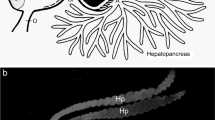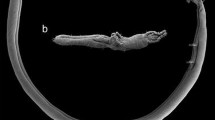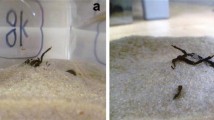Summary
Dendrocoelum lacteum, feeding on active prey, adopted a ‘sit and wait strategy’ upon starvation. During this time metabolic rate fell by a factor of 0.65. About 80% of the energy made available from the catabolism of tissue was lost as heat with the rest being lost as mucus. P. tenuis, feeding on inactive carrion, adopted a ‘search out strategy’ upon starvation. Metabolic rate fell during this time but only by a factor of 0.72. About 50% of the energy from catabolism was lost as heat and about 50% as mucus. Hence the locomotory strategies adopted by each species during starvation depended on the mobility of the prey and lead to marked differences in the energy balance of the worms.
Similar content being viewed by others
References
Bellamy, L.S., Reynoldson, T.B.: Behaviour in competition for food amongst lake-dwelling triclads. Oikos 25, 356–364 (1974)
Boddington, M.J., Mettrick, D.F.: Seasonal changes in the chemical composition and food reserves of the freshwater triclad Dugesia tigrina (Platyhelminthes: Turbellaria). J. Fish. Res. Board, Canada 28, 7–14 (1971)
Bolen, H.: Specific dynamic action in planaria. J. exp. Zool. 75, 389–412 (1937)
Brand, T. von: Anaerobiosis in invertebrates. Missouri: Biodynamica 1946
Calow, P.: Some observations on locomotory strategies and their metabolic effects in two species of freshwater gastropods, Ancylus fluviatilis Müll. and Planorbis contortus Linn. Oecologia (Berl.) 16, 149–161 (1974)
Calow, P.: Ecological implications of the joint effect of temperature and starvation on the metabolism of triclads. Oikos (in press, 1977a)
Calow, P.: Evolution, ecology and energetics; a study in metabolic adaptation. Adv. Ecol. Res. 10 (in press, 1977b)
Calow, P., Jennings, J.B.: Calorific values in the phylum Platyhelminthes: the relationship between potential energy, mode of life and the evolution of entoparasitism. Biol. Bull. 147, 81–94 (1974)
Carpenter, J.H.: The Chesapeake Bay Institute technique for the Winkler dissolved oxygen method. Limnol. & Oceanogr. 10, 141–143 (1965)
De Silva, P.K.: The factors affecting the feeding of Dendrocoelum lacteum (Muller) (Turbellaria, Tricladida) on Asellus aquaticus (L.) (Crustacea, Isopoda). Arch. Hydrobiol. 77, 347–374 (1976 a)
De Silva, P.K.: The importance of mucus of Dendrocoelum lacteum (Muller) (Turbellaria, Tricladida) in community existence. Arch. Hydrobiol. 78, 363–374 (1976 b)
Elliott, J.M., Davidson, W.: Energy equivalents of oxygen consumption in animal energetics. Oecologia (Berl.) 19, 195–201 (1974)
Hemmingsen, A.M.: Energy metabolism as related to body size and respiratory surfaces and its evolution. Rep. Steno. meml. Hosp. 9, 7–110 (1960)
Holland, D.L., Gabbott, P.A.: A micro-analytical scheme for the determination of protein, carbohydrate, lipid and RNA levels in marine invertebrate larvae. J. Mar. Biol. Ass., U.K. 51, 659–668 (1971)
Hyman, L.H.: The invertebrates: Platyhelminthes and Rhynchocoela. The Acoelomate Bilateria, Vol. II, pp. 1–550. New York: McGraw-Hill 1951
Jennings, J.B.: Studies on feeding, digestion and food storage in free-living flatworms (Platyhelminthes; Turbellaria). Biol. Bull. 112, 64–80 (1952)
Mettrick, D.F., Boddington, M.J.: The chemical composition of some marine and freshwater turbellarians. Carib. J. Sci. 12, 1–7 (1972)
Paine, R.T.: The measurement and application of the calorie to ecological problems. Ann. Rev. Ecol. Syst. 2, 145–164 (1972)
Reynoldson, T.B.: Preliminary laboratory experiments on recruitment and mortality in triclad populations. Verh. Int. Ver. Limnol. 16, 1621–1631 (1966 a)
Reynoldson, T.B.: The distribution and abundance of lake-dwelling triclads—towards a hypothesis. Adv. Ecol. Res. 3, 1–71 (1966 b)
Reynoldson, T.B.: Shrinkage thresholds in freshwater triclads. Ecology 49, 584–586 (1968)
Ricker, W.E.: Linear regression in fishery research. J. Fish. Res. Board, Canada 30, 409–434 (1972)
Teal, T.: Communicity metabolism in a temperate cold spring. Ecol. Monogr. 27, 283–302 (1957)
Whitney, R.J.: The relation of animal size to oxygen consumption in some freshwater turbellarian worms. J. exp. Biol. 19, 168–175 (1942)
Author information
Authors and Affiliations
Rights and permissions
About this article
Cite this article
Calow, P., Woollhead, A.S. Locomotory strategies in freshwater triclads and their effects on the energetics of degrowth. Oecologia 27, 353–362 (1977). https://doi.org/10.1007/BF00345568
Received:
Issue Date:
DOI: https://doi.org/10.1007/BF00345568




